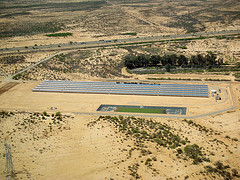Might Green Energy Replace Development as #1 Threat to Habitat?
By: Amos S. Eno
Posted on:08/19/2010 Updated:10/25/2010Connectivity, argues Ed Hastey, is the answer to a lot of our conservation problems on both public and private lands - but do energy companies realize that?
This blog is a continuation of last week’s conversation with Ed Hastey, former BLM California state director. He emphasizes that to achieve our conservation goals we all need to work together -- federal and state agencies, private landowners, and industry -- including green energy.
In the cur rent economic environment, Ed’s concerned that a new threat may be replacing that of subdivision: wind and solar energy. “We didn’t predict the impact those have,” he says. “They’re great, but those developments have a big impact, in certain cases bigger than hydrocarbon development. With solar incentives to increase development, what happens if the incentives stop? Once you’ve developed solar, it’s like a strip mine.”
rent economic environment, Ed’s concerned that a new threat may be replacing that of subdivision: wind and solar energy. “We didn’t predict the impact those have,” he says. “They’re great, but those developments have a big impact, in certain cases bigger than hydrocarbon development. With solar incentives to increase development, what happens if the incentives stop? Once you’ve developed solar, it’s like a strip mine.”
Reactive Development of Alternative Energy Projects
The problem is the way alternative energy projects are developed. It is precisely backwards. “On federal lands,” Ed says, “the feds are pretty much reactive to what developers propose. It should already have been decided: determine where the good sites are for green energy. Then get bids."
“This issue is a big one, people don’t recognize that. Green energy’s going to be our life saver, probably, but it has to be done right.”
I can envision federal and state agencies working closely with energy companies, private landowners and conservation organizations to come up with designated green energy development zones, strategically applying farm bill programs to protect habitat corridors on private lands.
Proactive Energy Development and Conservation
In fact, I discovered a partnership somewhat along that model already exists. Steve Thompson, retired FWS Regional Dire ctor for Region 8, told me to check in with Regional Director Benjamin Tuggle at the FWS Southwest Region. They have been negotiating voluntary agreements in New Mexico to manage both private and public lands for the benefit of two candidate T&E species: the Lesser Prairie-chicken and the Sand Dune Lizard.
ctor for Region 8, told me to check in with Regional Director Benjamin Tuggle at the FWS Southwest Region. They have been negotiating voluntary agreements in New Mexico to manage both private and public lands for the benefit of two candidate T&E species: the Lesser Prairie-chicken and the Sand Dune Lizard.
The oil industry, ranchers, and federal agencies are planning proactively to prevent those listings from happening. In 2008, rancher Chris Brininstool was the first to sign a Candidate Conservation Agreement with Assurances, or CCAA, covering two sections - 1,280 acres - of her private ranch land.
Next, grazing permittees and energy lease holders on federal lands signed a Candidate Conservation Agreement, or CCA. The innovative part of this agreement is that permittees conduct conservation management on public lands that do not belong to them.
Doug Burger, the BLM Pecos District Manager who works with most of the landowners, says that ranchers survive by grazing their cattle on a combination of ownerships, so they generally sign up their BLM and state allotments along with their privately held land.
As for the mining permittees, Ben Tuggle says, “It’s not generally recognized, but these companies are putting their money where their mouths are. They want to be good stewards, and our job is to let them know what they can do to minimize their impact and make better habitat.”
At least six energy firms have signed CCAs that commit them to practices such as minimizing surface disturbance, reducing and relocating the number of wells they plan to drill, and limiting infrastructure to locations that avoid habitat. As of August 2010, their agreements cover a combined area of 156,000 acres of federal and state land. An additional one million acres of combined federal, state and private land have either been enrolled or are in the process of being enrolled by 25 area ranchers.
The goals of both the CCA and CCAA are to reduce habitat fragmentation and disturbance, while maintaining or increasing connectivity between habitat patches. Ben tells me they are trying to recover two rare and declining species, and “the only way we're going to conserve these species is by looking at the threats to good habitat conditions and taking action on a landscape scale. And industry has a role to play.”
Private Land Stewardship of Public Lands Also Important
Private landowners and businesses bring the key ingredients of funding and manpower to this partnership, whose success will ultimately be measured by the ability to prevent further decline and listing of the Lesser Prairie-chicken and Sand Dune Lizard. In return, they receive assurances that, should the species ever come under the protection of the Endangered Species Act, their private land operations will continue. Even operators on federal lands have a greater degree of certainty concerning future operations, since they have already gone through the consultation process and are “doing things right.”
Back to Ed Hastey’s original point: the old model for federal and state agencies to conduct acquisition in the middle of “white space” with no thought of surrounding lands is out. Ed says, “That’s why we’re focusing on connectivity. A lot of work has been done on corridor studies. Big and small animals have to be able to move to higher elevations, or to seek refuge from big disturbances such as fire.”
In short, “Connectivity at the landscape scale is really an answer to a lot of our problems, and that’s where private lands play a big role.” And private companies as well.
Feedback
re: Might Green Energy Replace Development as #1 Threat to Habitat?By: Debra Carpenter on: 12/10/2010In the eastern cornbelt, the high prices of commodity crops is leading farmers to tear out more and more private forests, both large and small. Although many economic forces are at work here, the demand for corn for ethanol production is one of them. We need to somehow find a balance between the production of home-grown fuels and wise land use choices for the future. Too many farmers look at that patch of woods as just wasted land. Perhaps the USDA should shift some of the money spent on DCP payments to incentives for forest management.
 Sign In
Sign In
 Sign In
Sign In
